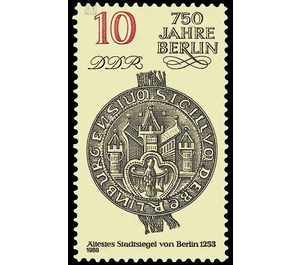Commemorative stamp series - Germany / German Democratic Republic 1986 - 10 Pfennig
Theme: Science
| Country | Germany / German Democratic Republic |
| Issue Date | 1986 |
| Face Value | 10.00 |
| Color | brown |
| Perforation | K 12 1/2: 13 |
| Printing Type | combined intaglio and offset printing |
| Stamp Type | Postage stamp |
| Item Type | Stamp |
| Chronological Issue Number | 2765 |
| Chronological Chapter | GER-DDR |
| SID | 532645 |
| In 20 Wishlists | |
750 years Berlin (issue 1986) The Ministry of Posts and Telecommunications of the German Democratic Republic publishes four multicolored special postage stamps and a block "750 years Berlin". Special cancellation from June 3 to August 2, 1986 750th anniversary of Berlin On October 28, 1237, Berlin was first mentioned in a document; an event that received a high level of social recognition in 1987. The 750th anniversary of Berlin will bring together the citizens of Berlin with their friends from the socialist fraternal countries as well as from all over the world looking back on history and progressing into the future: to do everything for the strengthening of socialism, for the happiness and well-being of the entire people. for the protection of peace, for the prosperity of this city and its inhabitants. There is hardly a second city in the world in whose history societal relations from the Middle Ages to the present day are reflected as clearly as in Berlin. This began with the emergence of the medieval trading city on a ford through the marshy glacial valley of the Spree. Here two trade routes intersected; Here the traveling merchants rusted, repaired their vehicles and traded. Inner-city strife for advantages and privileges brought the twin city of Berlin / Cölln in the 15th century under the rule of the elector of Brandenburg and later Prussian kings from the House of Hohenzollern. They degraded Berlin until the mid-19th century to a court and royal residence. With the development of capitalism Berlin grew by the access of hundreds of thousands of workers until 1875 to the metropolis. Capitalist exploitation combined with the unrestrained suppression of any progressive development by the authorities led to the emergence of an organized labor movement in Berlin whose traditions and goals became reality with the foundation of the German Democratic Republic in its capital Berlin. Until this historic turning point in its history, however, the city underwent and suffered social processes of the utmost importance. They started here for the most part and returned here as well. Berlin gained worldwide fame as a city of science and the arts and equally as the stain as the largest tenement barracks in Europe. From this came impulses for the development of humanistic goals and at the same time took from here two devastating world wars their destroying human. Finally they laid Berlin itself to rubble and ashes. The city was finally freed on 2 May 1945 by the glorious Red Army of the Soviet Union from the yoke of fascism. The road to building a developed socialist society in the German Democratic Republic founded on 7 October 1949 with its capital Berlin was leveled. At the celebrations for the 750th anniversary of the city of Berlin, this development should be reflected in many performances and events. They will open the chapter of the history of the city, which began on the Liberation Day in 1945 and bears witness to a social development that brought more social security, security and confidence to the citizens than in the whole time before. It presents itself optimistically looking into the future, peace-loving and lovable capital of the German Democratic Republic, Berlin, in whose shape the working people of our socialist state have a large share. For the time being, this social event will be honored with the publication of four special postage stamps on early Berlin history and a block. 10 Pfennig value: Oldest city seal of Berlin 1253 The oldest Berlin city seal shows the privileges of the medieval trading city: The seal Berlin "in Latin, the image of a city fortification as a concept of urban freedoms and the Brandenburg Red Eagle in the city gate as a reference to the Supremacy of the Margraves of Brandenburg.


